STS-51-B
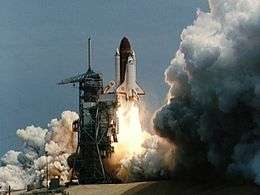 Challenger launches on STS-51-B | |||||
| Mission type | Microgravity research | ||||
|---|---|---|---|---|---|
| Operator | NASA | ||||
| COSPAR ID | 1985-034A | ||||
| SATCAT № | 15665 | ||||
| Mission duration | 7 days, 8 minutes, 46 seconds | ||||
| Distance travelled | 4,651,621 kilometres (2,890,383 mi) | ||||
| Orbits completed | 111 | ||||
| Spacecraft properties | |||||
| Spacecraft | Space Shuttle Challenger | ||||
| Launch mass | 111,980 kilograms (246,880 lb) | ||||
| Landing mass | 96,373 kilograms (212,465 lb) | ||||
| Payload mass | 15,610 kilograms (34,415 lb) | ||||
| Crew | |||||
| Crew size | 7 | ||||
| Members |
Robert F. Overmyer Frederick D. Gregory Don L. Lind Norman E. Thagard William E. Thornton Lodewijk van den Berg Taylor G. Wang | ||||
| Start of mission | |||||
| Launch date | April 29, 1985, 16:02:18 UTC | ||||
| Launch site | Kennedy LC-39A | ||||
| End of mission | |||||
| Landing date | May 6, 1985, 16:11:04 UTC | ||||
| Landing site | Edwards Runway 17 | ||||
| Orbital parameters | |||||
| Reference system | Geocentric | ||||
| Regime | Low Earth | ||||
| Perigee | 346 kilometres (215 mi) | ||||
| Apogee | 352 kilometres (219 mi) | ||||
| Inclination | 57.0 degrees | ||||
| Period | 91.5 minutes | ||||
| Epoch | May 1, 1985[1] | ||||
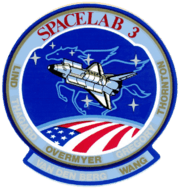 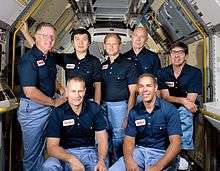 L-R: (sitting): Overmyer, Gregory (standing): Lind, Wang, Thagard, Thornton, van den Berg
| |||||
STS 51-B was the seventeenth flight of NASA's Space Shuttle program, and the seventh flight of Space Shuttle Challenger. The launch of Challenger on April 29, 1985 was delayed by 2 minutes and 18 seconds, due to a launch processing failure. Challenger was initially rolled out to the pad to launch on the STS-51-E mission. The shuttle was rolled back when a timing issue emerged with the TDRS-B satellite. When STS-51-E was canceled, Challenger was remanifested with the STS-51-B payloads. The shuttle landed successfully on May 6, 1985, after a week-long mission.
Crew
| Position | Astronaut | |
|---|---|---|
| Commander | Robert F. Overmyer Second spaceflight | |
| Pilot | Frederick D. Gregory First spaceflight | |
| Mission Specialist 1 | Don L. Lind Only spaceflight | |
| Mission Specialist 2 | Norman E. Thagard Second spaceflight | |
| Mission Specialist 3 | William E. Thornton Second spaceflight | |
| Payload Specialist 1 | Lodewijk van den Berg Only spaceflight | |
| Payload Specialist 2 | Taylor G. Wang Only spaceflight | |
Backup crew
| Position | Astronaut | |
|---|---|---|
| Payload Specialist 1 | Mary Johnston First spaceflight | |
| Payload Specialist 2 | Eugene H. Trinh First spaceflight | |
Crew seating arrangements
| Seat[2] | Launch | Landing | 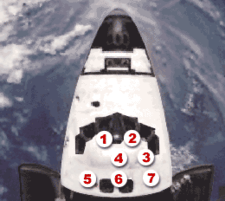 Seats 1–4 are on the Flight Deck. Seats 5–7 are on the Middeck. |
|---|---|---|---|
| S1 | Overmyer | Overmyer | |
| S2 | Gregory | Gregory | |
| S3 | Lind | Lind | |
| S4 | Thagard | Thagard | |
| S5 | Thornton | Thornton | |
| S6 | van den Berg | van den Berg | |
| S7 | Wang | Wang | |
Mission summary
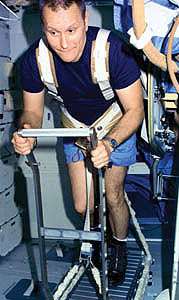
Challenger lifted off from Kennedy Space Center (KSC)'s launch pad 39A at 12:02 pm EDT on April 29, 1985. The crew members included Robert F. Overmyer, commander; Frederick D. Gregory, pilot; Don L. Lind, Norman E. Thagard and William E. Thornton, mission specialists; and Lodewijk van den Berg, of EG&G Energy Management, Inc., and Taylor G. Wang, of the Jet Propulsion Laboratory, both payload specialists.[3] Similar to the previous Spacelab mission, the crew was divided roughly in half to cover 12-hour shifts, with Overmyer, Lind, Thornton and Wang forming the Gold team, and Gregory, Thagard and van den Berg as the Silver team.
STS-51-B was the second flight of the European Space Agency's Spacelab, and the first with the Spacelab module in a fully operational configuration. Spacelab's capabilities for multi-disciplinary research in microgravity were successfully demonstrated. The gravity gradient attitude of the orbiter proved quite stable, allowing the delicate experiments in materials processing and fluid mechanics to proceed normally. The crew operated around the clock in two 12-hour shifts. Two squirrel monkeys and 24 rats were flown in special cages,[4] the second time American astronauts flew live non-human mammals aboard the shuttle. The crew members in orbit were supported 24 hours a day by a temporary Payload Operations Control Center, located at the Johnson Space Center.
On the mission, Spacelab carried 15 primary experiments, of which 14 were successfully performed. Two Getaway Special experiments required that they be deployed from their canisters, a first for the program. These were NUSAT (Northern Utah Satellite) and GLOMR (Global Low Orbiting Message Relay Satellite). NUSAT deployed successfully, but GLOMR did not deploy, and was returned to Earth.
Challenger landed safely at Edwards Air Force Base at 12:11 pm EDT on May 6, 1985, after a mission lasting 7 days, 8 minutes and 46 seconds.
Connection to the Challenger disaster
While participating in the investigation into the destruction of Challenger during STS-51-L in 1986, Overmyer discovered that a problem with the shuttle's O-rings, similar to that which led to the disaster, had emerged during the launch of STS-51-B. Morton Thiokol engineers told Lind after the mission that "you came within three-tenths of one second of dying."[5] It was the problem with the O-rings on the left solid rocket motor on this launch (SRM 16A) that prompted Roger Boisjoly to write his famous memo to Bob Lund about the potential for the O-rings to cause catastrophic failure. (See "Report of the Presidential Commission on the Space Shuttle Challenger Accident". Report of the Presidential Commission on the Space Shuttle Challenger Accident, Volume 5.)
See also
References
![]() This article incorporates public domain material from websites or documents of the National Aeronautics and Space Administration.
This article incorporates public domain material from websites or documents of the National Aeronautics and Space Administration.
- ↑ McDowell, Jonathan. "SATCAT". Jonathan's Space Pages. Retrieved March 24, 2014.
- ↑ "STS-51B". Spacefacts. Retrieved February 26, 2014.
- ↑ Fichtl, George H.; Theon, John S.; Hill, Charles K.; Vaughan, Otha H. "Spacelab 3 Mission Science Review". NASA. Marshall Space Flight Center. Retrieved September 27, 2011.
- ↑ PROGRAMS, MISSIONS, AND PAYLOADS STS-51B/Spacelab 3, NASA
- ↑ "NASA Johnson Space Center Oral History Project" (PDF). Don L. Lind oral history transcript. May 27, 2005.